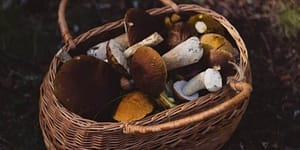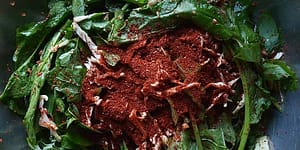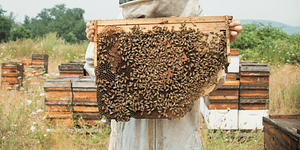The Power of the Mesquite Tree

The miraculous abundance provided by the mesquite tree continues to astound us. It offers a plethora of culinary possibilities. It has the power to cure, to shelter, to elicit profound emotions, and to connect us to our environment and our neighbors in a way we may not have thought about before.
The following excerpt is from Mesquite by Gary Paul Nabhan. It has been adapted for the web.
When I was in my Terrible Twenties, I purchased my first chainsaw for cutting mesquite wood, in the hopes that I might become a ramada builder some day.
Several years before I cut my teeth on my own chainsaw, I had a rite of passage into the world of traditional leñeros and ramada builders, the humblest of los amigos del mesquite. I had the chance to apprentice myself to an elderly woodcutter and master ramada builder, whom I will call Remedio Cruz. The old man taught me how to use an ax properly, which included how to not kill a tree but prune it for future uses. For that lesson alone, I will be eternally grateful to Remedio.

When I knew him as an old man, Remedio was widely heralded as the Ramada-Builder of Highest Regard among Hispanic-, Anglo- and Native American woodcutters alike. He had probably learned his technique for pruning or coppicing mesquite trees a half century earlier, from the oldest of his male kin on both sides of the border. Remedio himself was born just south of the Arizona border in Mexico. At that time, there wasn’t even a single barbed-wire strand strung between two mesquite fence posts along the entire boundary line dividing the two countries.
Remedio was still a boy when he learned to gather dead mesquite branches from the desert floor that his grandmother could use for kindling. He and his cousins would disassemble flood-tumbled or drought-stricken trees and stack them into cords. For such work, they would employ stout iron-headed axes and two-man crosscut saws forged from 18-gauge steel. When Remedio turned sixteen, he was sent to the copper mines in Ajo, Arizona, to cut both ironwood and mesquite for their smelters, blast furnaces, forges, and fences. He did so in a way that he knew would keep the trees themselves alive, but I wonder if his crew bosses at Phelps-Dodge ever noticed that. They were good at thinking about extraction and reclamation, but not so well versed in concepts like regeneration and restoration.
By the time I met Remedio, he was pushing seventy. He was still cutting mesquite with his old iron ax that he carried over his shoulder like a lumberjack half his age.
“I got no use for them chainsaws my boys bring home. Them things are always breaking down,” he told me flatly. “And you gotta buy diamond blades hard enough to cut both ironwood and mesquite. They ain’t cheap. I can hardly afford a diamond for my wife, so why would I go and buy one to put on a greasy saw?”
He had worked for years cutting fence posts and corral logs for farmers and ranchers along the Rio Santa Cruz south of Tucson. One time he built a mesquite retaque, or stacked log corral, on a ranch near Tumacacori, Arizona. It required more than fifty cords of straight 6- to 7-foot logs to make a 50-yard square rodeo arena where ranch hands and drugstore cowboys would train horses for calf-roping and bulldogging. He knew how to size up a branching trunk so that it would offer a couple of sturdy fence posts without losing its canopy. He was also expert at selecting Y-shaped trunks for cutting so that their branching happened at the very same height. These served as perfect upright posts both for ramadas and for hoists used to skin, eviscerate, and butcher fresh-killed beeves.
Remedio was exceedingly picky about the length, girth, and taper of his fence posts. He was discerning in other ways he selected and harvested mesquite as well. He cut them during just one prime period all year, for fear of how quickly termites might ravage them if he cut them out of season.
“You gotta cut mesquite in the spring before it gets hot in June. It’s best in late May. Not all the woodcutters agree with me on that, but when I go back and look at a post years later, that’s what matters for keeping the termites from rotting them. If you cut them after the summer rains begin, when the sap from the roots has already run up in the trunk, all the bugs like to come and eat them, because they are full of sugar. You don’t want the posts to have a lot of sugar or moisture, or these termites and worms and beetles will riddle them with holes.”
That had already become the longest lecture I had ever received from Remedio, but he continued on from there:
“Cut them at the wrong time of year and they’ll be no good. Go get them when they’re in the right season and right moon if youwant them to last forever. See that fence o’er there? We cut those fence posts with my bro’er-in-law right after he came back from World War II. Just look, still real good and straight. My bro’er-in-law’s already gone, but that fence we did together, it’s still standing.”
He would cut posts and even firewood for neighbors, ranchers, and park rangers for their fences, picnic areas, and ramadas. One time when I stayed with Remedio and his wife, Molly, he woke me up at four in the morning on a day in late May. Remedio whispered that it was time to go for a walk to get some 9-foot-long mesquite posts. He had cut them a month earlier for a ramada he was building for their church. I quickly got dressed, pulled on my cowboy boots, and went into the kitchen. Molly gave each of us a burrito of leftover beans wrapped in a cold stiff wheat tortilla made the day before.
“Sorry we don’t got no coffee brewing or no fresh tortillas,” she whispered. “He says he wants to go out there and back before it gets hot when the sun comes up. He don’t drink no water or coffee when he walks that far. Says it makes his stomach ache. But you take some along in case he don’t have any water out there for you.”
We set out well before the twilight began to settle on the eastern horizon. He knew the path like the back of his hand, even though his woodcutting site was at least a mile away, across a wide flood-plain of braided arroyos. He didn’t follow any road; he just meandered down dusty cattle paths no more than 4 feet wide. In the dim light before dawn, the trail sometimes seemed obscured by brush and shadows in the bosque, but I could always see enough open space before my feet that I could have avoided rattlesnakes if there had been any. At most, I spotted a couple of cotton rats and one kangaroo rat hopping away.
When we arrived at Remedio’s wood-harvesting site, all the trees around it initially appeared to be uncut, with no recent saw marks or ax blows. Then Remedio quietly pointed out where he had pruned sizable branches away from the tangle of multistemmed trunks. He directed me to where, a month before, he had hidden the last four 9-footers to dry, spread across a few gnarly logs that elevated the posts off the ground. They had perfectly shaped Ys at the top of them, so as to support the horizontal vigas that we would extend between them once we had sunk their trunks back into the ground.
“I put ’em back in that small clearing surrounded by bushes just in case, so no cowboy could come along on his horse or pickup and carry them away. The last four, two for me, two for you. I already carried the other ten. Here, I’ll load you up first, then get my own.”
Lucky I was in decent shape back then. I thought I’d sink into the sand when he balanced each of the two 9-footers across my shoulders.
“Just start walking slowly but keep on moving. You know, like them desert tortoises. If you begin to get tired, don’t put them down, or we’ll never get them back up. Just slow down a little bit. Now go ahead on this straight stretch. I’ll load myself up and then I’ll catch up with you, to lead you through the brushy part. You should be able to see okay all the way, ’cuz it’s already getting to be light. That’s why we gotta get back home before the sun beats down on us.”
I put one work boot in front of the other and chanted a song he had taught me. My shoulder and neck muscles cramped and ached, but I kept going. He soon passed me, and as he heard me chant his work song, he began singing it, too. Whenever he got out of sight and I became confused about which way to go, I just listened for which way the song was going.
Once Remedio was back in my sight, I started to relax, even daydream. I imagined the ramada I hoped to build behind my house, but as soon as I did that I realized that mesquite trees themselves had become my shelter from the cold, a buffer from the heat and sun, a protected harbor and refuge from some predators.
Recommended Reads
Recent Articles
Beavers are ecological and hydrological Swiss Army knives. Capable of tackling just about any landscape-scale problem you might confront.
Read MoreWhen you’re walking around the grocery store looking at the vegetables, it’s probably hard to imagine that a century ago there was twice the amount of options.
Read MoreFor people who enjoy foraging for food in the wild, there are plenty of mushrooms to choose from — “ten thousand mushroom species to be considered on the North American continent alone”. But foraging for mushrooms should never be thought of as a game of chance. You need to know all the clues when it comes to identifying…
Read MoreNeed a new twist on kimchi? Look no further than this wild green kimchi! Experiment with what you have, anything from the mustard family will work extremely well.
Read MoreFor all the beekeepers and future beekeepers out there, this one is for you! Your journey to successful beekeeping begins with constructing a suitable haven for honeybees, otherwise known as the bee hive. The following is an excerpt from Raising Resilient Bees by Eric and Joy McEwen. It has been adapted for the web. Bees…
Read More








